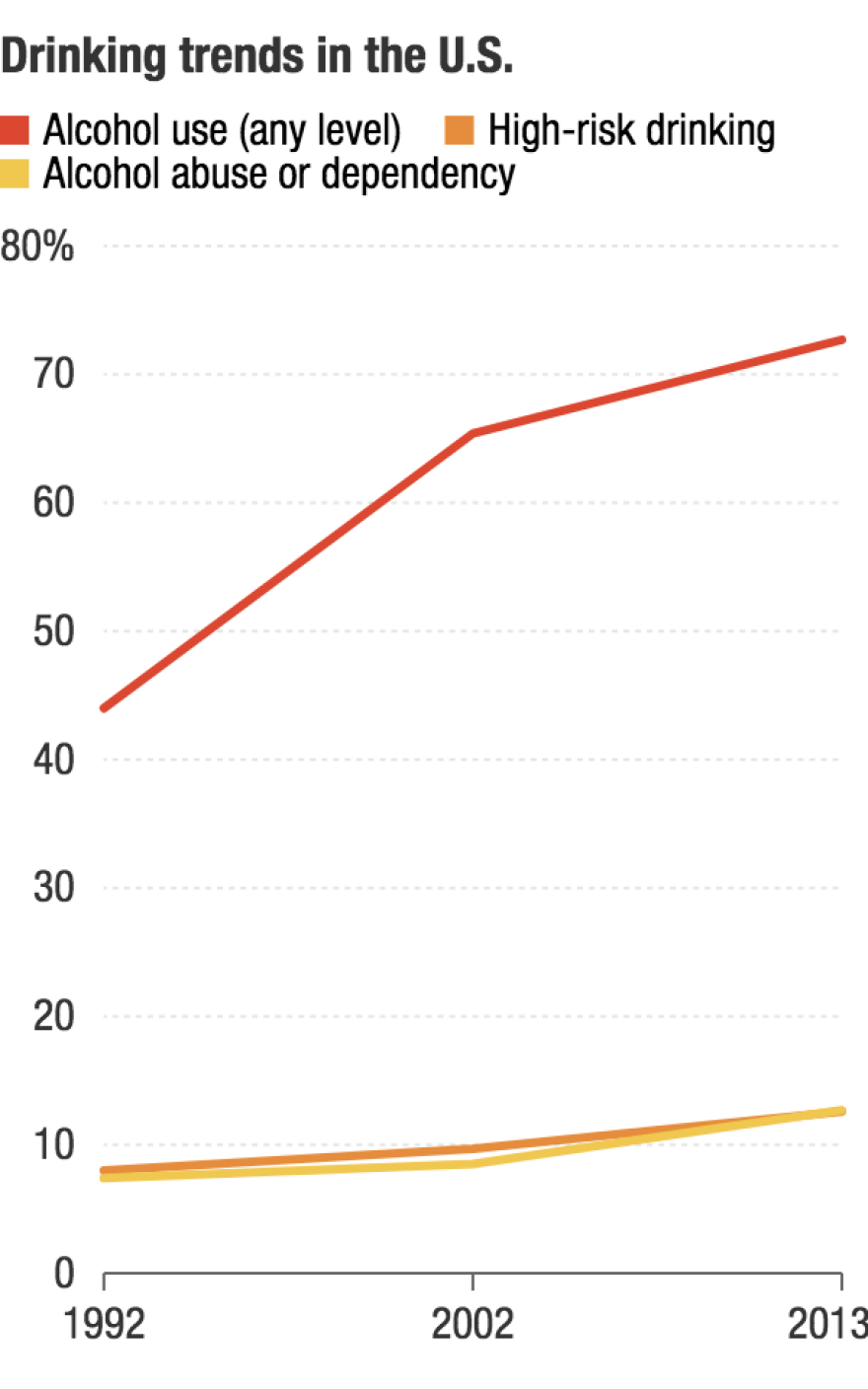More Americans are drinking alcohol, and a growing number of them are drinking to a point that's dangerous or harmful, according to a new study published in JAMA Psychiatry this week.
The study, sponsored by a federal agency for alcohol research, examined how drinking patterns changed between 2002 and 2013, based on in-person surveys of tens of thousands of U.S. adults.
They found that drinking, in general, rose substantially over that time frame. Problem drinking increased by an even greater percentage, and women, racial minorities, older adults and the poor saw particularly large spikes.
The findings suggest "a public health crisis," the researchers say, given the fact that high-risk drinking is linked to a number of diseases and psychiatric problems, as well as violence, crime and crashes.

"These findings portend increases in many chronic comorbidities in which alcohol use has a substantial role," the researchers write.
Previous research showed steady or declining drinking patterns from the 1970s through the 1990s, the report says. In the '90s, however, alcohol consumption increased — the percentage of people who drank at all increased by nearly half, while high-risk and disordered drinking increased by about 20 percent and 12 percent, respectively.
Between 2002 and 2013, overall drinking increased by 11 percent. By 2013, nearly three-quarters of American adults said they had consumed alcohol within the last year. The increase was in drinking present for all groups, but particularly noteworthy for minorities (for instance, a nearly 30 percent increase for Asians and Pacific Islanders) and people over 65 (a 22.4 percent increase.)
But high-risk and problem drinking increased far more dramatically.
High-risk drinking, in this study, referred to women drinking four or more drinks in a day, or men drinking five or more drinks in a day, on a weekly basis. High-risk drinking overall rose by 29.9 percent.
Among women, it rose about 58 percent; among older adults, it rose 65 percent.
And then there's problem drinking. The study looked at both alcohol abuse, which is drinking to the point where it causes recurrent and significant problems in your life, or alcohol dependence, which is in part the inability to stop drinking.

Problems with alcohol increased by nearly 50 percent. Among women, alcohol abuse and dependence increased by 83.7 percent. Among black people, it increased by 92.8 percent. Among the poor (earning less than $20,000) it rose by 65.9 percent.
And among older adults, abuse and dependence more than doubled.
The researchers didn't theorize as to why older adults are drinking more than they used to. But they noted that the increase in high-risk and problem drinking among older adults is "unprecedented." And it's worrying, because older adults at are a high risk of death, injury or disease connected to alcohol use — from falls, for instance, or from adverse interactions between drugs and drinking.
As for women, the results show a narrowing of the "gender gap" in drinking disorders, which is consistent with previous research. That is, men are still more likely than women to be problem drinkers, but women are catching up. Changing social norms around female alcohol consumption are part of the equation, the study says — but stress may be another factor.
Meanwhile, the study found a "generally much greater" increase in drinking among minorities than white Americans. The researchers suggest that growing wealth inequality between whites and minorities may have led to "increased stress and demoralization," while educational, employment, housing and health disparities faced by non-white Americans may also lead to increased coping behaviors.
Copyright 2021 NPR. To see more, visit https://www.npr.org. 9(MDA5NTM4MTIyMDE0MTg3NDc2MTVlZjdmNQ001))





